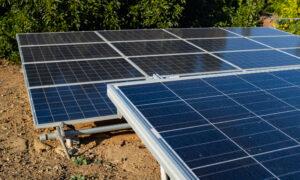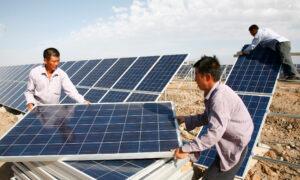Manufacturers say Biden’s order nearly doubling the solar tariff quota rate will sustain momentum while onshoring production currently dominated by China.
The United States’ $60 billion solar energy industry is poised for rapid expansion in the coming decade, but American manufacturers say they’re struggling to compete with low-cost photovoltaic (PV) cell imports from Southeast Asia factories mostly owned by subsidized Chinese corporations.
The U.S. solar industry “has been making and is continuing to make a positive adjustment to import competition, shown by increased actual and planned module production; various announcements of planned domestic cell production; and improvements in several of the domestic industry’s financial, trade, and employment indicators,” Biden said.
The move was in response to an April petition from seven domestic solar manufacturers—and a May report from the U.S. International Trade Commission (USITC) citing unfair trade practices and market manipulation by Chinese companies—eluding “China-wide” U.S. tariffs by exporting solar panels and components made in Cambodia, Malaysia, Thailand, and Vietnam.
The tariff rate quota boost will provide certainty for domestic manufacturers, but could also backfire by making solar panels more expensive, stymying the Solar Energy Industries Association’s (SEIA) forecasted doubling of industry-related U.S. jobs from 260,000 to nearly 600,000 by 2032.
The move was applauded by Washington-based SEIA, the national trade association for the U.S. solar industry.
“This decision will help create a strong, stable module manufacturing sector that can sustain robust cell production in the long run.”
The American Clean Power Association, Interstate Renewable Energy Coalition (IREC), The Institute for Energy Research (IER), Coalition for a Prosperous America, and American Alliance for Solar Manufacturing Trade Committee were among the organizations that did not respond to email and phone queries from The Epoch Times on Aug. 13 and Aug. 14 or declined comment until later this week.
The Washington-based American manufacturing trade committee includes representatives from seven leading U.S.-based solar manufacturers—Convalt Energy, First Solar, Meyer Burger, Mission Solar, Qcells, REC Silicon, Swift Solar—that filed the April petition with the U.S. Department of Commerce (DOC).
Several members pushed for the quota to be raised to 20 GW—or eliminated—claiming increasing demand for solar would allow them to eventually be sustainable without tariffs.
First Solar Communications Director Reuven Proenca told The Epoch Times in an email the company would “have no comments” on the tariff rate quota hike but would address other issues within the global solar market in the coming days.

Tariff Timeline
The tariff rate quota imposed under Section 201 of the 1974 Trade Act limits the amount a product can be imported at reduced duty rates during a specific period. Once the quota is reached, it can still be imported, but at a higher duty rate.
Under the Biden administration’s tariff rate quota, retroactive to Aug. 1, U.S. manufacturers can import up to 12.5 GW of solar cells a year before paying a 14.25-percent tariff.
The tariff rate quota was originally installed at 2.5 GW in 2018 by the Trump administration. Biden bumped it to 5 GW in 2021.
Energy costs account for about 40 percent of the cost of solar panels, assorted studies maintain.
In their letter, they noted in 2023, the price of manufacturing a solar panel in China fell to 15 cents per watt, more than 60 percent less than in the United States.
“By 2026, China will have enough capacity to meet annual global demand for the next 10 years. This capacity is an existential threat to the U.S. solar industry and American energy security,” they wrote.
They called on the administration to “signal that the United States will not be a dumping ground for foreign solar products,” which has “led to a historic glut of solar panels believed to be sold at prices below the cost of production.”

Complex ‘Tariff Landscape’
Regardless of what actions the United States and European Union take, energy research firm Wood Mackenzie forecast in November 2023 that Chinese-owned companies will still dominate more than 80 percent of global solar panel production through 2026.
San Francisco, California-based SPV Market Research founder Paula Mints told The Epoch Times the “U.S. tariff situation is a bit more complicated” than black-and-white analyses suggest.
Mints said the growing U.S. solar market is drawing global investors, including from China. At least seven China-based companies with domestic subsidiaries are building, or have built, solar manufacturing plants in the United States in the past few years.
“China-based manufacturers are not the only ones building solar manufacturing in the United States,” she said in an email, citing South Korea’s Hanwha, Switzerland’s Meyer Burger, and Singapore’s Maxeon among foreign companies building U.S. solar manufacturing plants.
“So, the [tariff rate quota] question should really apply to all of them,” Mints said. “The quota hike, 12.5 GW of cells, is low, given the 30 GW of available module assembly capacity” already imported.
Critics, such as financial adviser Peter Schiff, fear the Biden administration’s efforts to promote domestic solar manufacturing through “protectionist policies” may cause solar panel prices to soar, making them unaffordable and, thus, suppressing demand.
“Biden wants green energy made in America, so he imposed heavy tariffs on imported solar panels. The higher cost made installing them uneconomical for customers. So demand collapsed.”
SunPower, a leader in U.S. solar energy development for decades, declared bankruptcy on Aug. 5.
It attributed its struggles to interest rates and net metering changes in California, not lower-cost Chinese imports but, critics such as Schiff say the administration’s actions didn’t make them more competitive.
“The cost of solar panels went up. So as demand fell, so did SunPower’s sales and revenue. So they went bankrupt,” he wrote.
“Higher interest rates also make financing more expensive solar panels even more expensive. So it wasn’t just the tariffs. But the tariffs were a major factor.”
Trump generally favors broader use of tariffs than both Biden and 2024 Democrat presidential candidate Vice President Kamala Harris do, but it’s unlikely solar tariff rate quotas will be a campaign issue, Mints said.
“Tariffs on imported solar cells, modules, and, in the future, polysilicon, and wafers will remain part of the U.S. solar reality no matter which candidate wins the 2024 presidential election,” she said.
Original News Source Link – Epoch Times
Running For Office? Conservative Campaign Consulting – Election Day Strategies!


